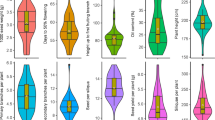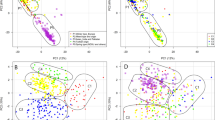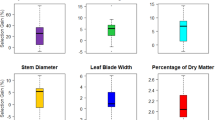Summary
The univariate method of predicting the properties of the inbred lines produced by single seed descent for single or pairs of independent characters is extended to predict their properties for two or more characters simultaneously irrespective of their interrelationships. The bivariate and trivariate predictions for two and three characters segregating simultaneously require only one parameter, the additive genetic correlation between pairs of characters, in addition to those required for the univariate case. Satisfactory estimates of all the parameters can be obtained early in the inbreeding programme for an F2 triple test-cross.
The procedures for making bivariate and trivariate predictions are illustrated using parameters estimated from an inbred triple test-cross and for one pair of characters from an F2 triple test-cross, all the material being derived from a cross between varieties 1 and 5 of Nicotiana rustica. The predictions are compared with the properties of a random sample of 80 F11 families derived by single seed descent from the same cross.
Although there appears to be a good overall agreement between the predicted and observed properties of the F11 families, a statistical test of the accuracy of the predictions must await larger sample sizes than the 80 families currently available.
Similar content being viewed by others
Article PDF
References
Eaves, L J, and Brumpton, R J. 1972. Factors of covariation in Nicotiana rustica. Heredity, 29, 151–175.
Jinks, J L, and Pooni, H S. 1976. Predicting the properties of recombinant inbred lines derived by single seed descent. Heredity, 36, 253–266.
Kearsey, M J, and Jinks, J L. 1968. A general method of detecting additive, dominance and epistatic variation for metrical traits. I. Theory. Heredity, 23, 403–409.
Mather, K, and Jinks, J L. 1971. Biometrical Genetics, pp. 382. Chapman and Hall, London.
Owen, D B. 1956. Tables for computing bivariate normal probabilities. Annals Math Stat, 27, 1075–1090.
Perkins, J M. 1972. The principal component analysis of genotype environmental interactions and physical measures of the environment. Heredity, 29, 51–70.
Perkins, J M, and Jinks, J L. 1970. Detection and estimation of genotype-environmental, linkage and epistatic components of variation for a metrical trait. Heredity, 25, 157–177.
Pooni, H S, and Jinks, J L. 1976. The efficiency and optimal size of triple test-cross designs for detecting epistatic variation. Heredity, 36, 215–227.
Pooni, H S, Jinks, J L, and Cornish, M A. 1977. The causes and consequences of non-normality in predicting the properties of recombinant inbred lines. Heredity, 38, 329–338.
Steck, G P. 1958. A table for computing trivariate normal probabilities. Annals Math Stat, 29, 780–800.
Author information
Authors and Affiliations
Rights and permissions
About this article
Cite this article
Pooni, H., Jinks, J. Predicting the properties of recombinant inbred lines derived by single seed descent for two or more characters simultaneously. Heredity 40, 349–361 (1978). https://doi.org/10.1038/hdy.1978.42
Received:
Issue date:
DOI: https://doi.org/10.1038/hdy.1978.42
This article is cited by
-
Impact of seasonal changes on spikelets per panicle, panicle length and plant height in rice (Oryza sativa L.)
Euphytica (2011)
-
Candidacy of a chitin-inducible gibberellin-responsive gene for a major locus affecting plant height in rice that is closely linked to Green Revolution gene sd1
Theoretical and Applied Genetics (2011)
-
The genetical basis of hybrid vigour in a highly heterotic cross of Nicotiana tabacum
Theoretical and Applied Genetics (1994)
-
Prediction of F6 line performance from F3 families in spring oilseed rape. I. Yield and other agronomic traits
Euphytica (1993)
-
Estimating the potential of sugarcane families to produce elite genotypes using bivariate prediction methods
Theoretical and Applied Genetics (1992)



